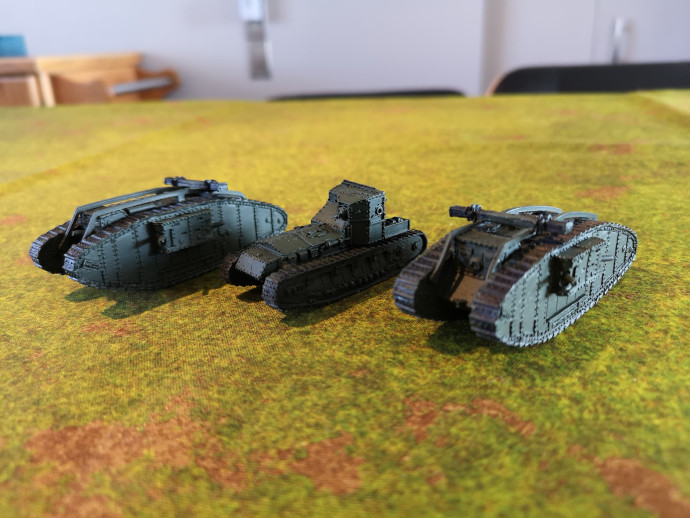Celebrate the launch of Great War! Alex and Wayne sit down to answer questions sent in from the community!
Great War Book Spotlight
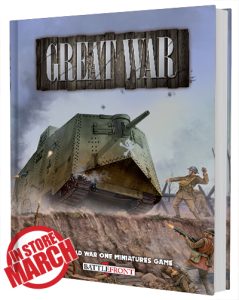 1918 Western Front further expanded!
1918 Western Front further expanded!
This year we have expanded our original Great War book and expanded it to include full rules and more forces. Great War now uses the same rules system as the new version of Flames Of War, version 4 as is commonly called. Great War has come a long way since it was released as a free booklet with Wargames Illustrated 324. The book now comes with the complete rules, missions and comprehensive forces for the Western Front in 1918.
Great War, like ‘Nam and Fate Of A Nation, comes with a full set of rules based of Flames Of War. This means that the Great War book contains all the rules and force list you need to play. Just add your Great War models, terrain, some dice, and a tape measure and you are ready to go.
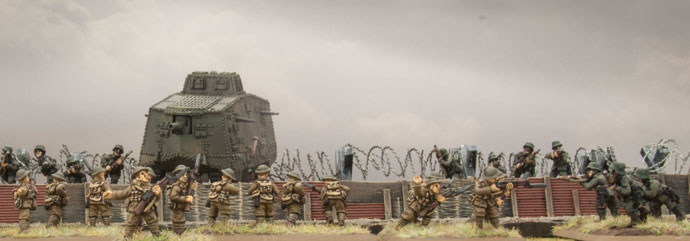
Like Flames Of War, Great War Units and Formations have their own cards for quick reference. These are available in four card packs, German, British, American and French (which includes the Belgians).
Forces include British and Dominion, German, French, United States, and Belgium.
The Germans
The Germans now have four Formations in their Force. These are the original Infanteriekompanie (Infantry Company) and Stosskompanie (Shock Company). To this we have added a Jägerkompanie (Light Infantry Company) and a Siegfriedstellung (Siegfried Line Position).
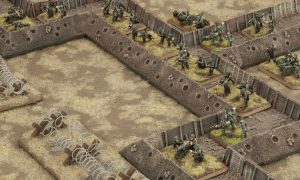
The Infanteriekompanie represents the average German formation found in the front lines. It is a strong formation with plenty of weapons options like machine-guns, anti-tank guns, and mortars (minenwerfer).
During 1918 the Germans launched a series of offensives to take advantage of the influx of manpower available when the Russians dropped out of the war after their revolution. One the key elements to lead these attacks were the Stoss (Shock) or Sturm (Assault) Battalions. To represent these elements you can field a Stosskompanie. This company of elite shock troops is supported by machine-guns and mortars to pin the enemy while they close quickly to launch their deadly assault.
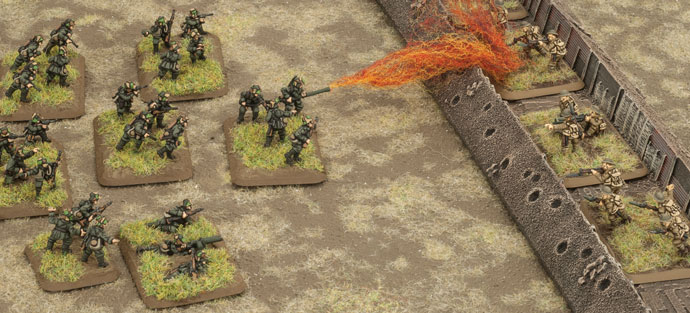
As the doctrine of Stosstaktik (Shock Tactics) began to spread throughout the German armies, other units began to be utilised in a similar manner. The Jäger battalions (Light Infantry) began to be trained in Stosstaktik methods. The Jäger troops retained much of their standard equipment, but combined with the new tactics. This proved very successful, giving them a reputation almost as great as that of the specialist Stoss units.
The final German formation represents of the German defensive tactics of the final campaigns of the war, where defence in depth based around strongpoints, backed by vigorous counterattacks, became the standard German tactics. This formation is a few men, many weapons unit. These veterans hold the front line. To back these up to take another formation to act as your counterattacking force to arrive from reserve.

The British
The British force now includes Line Division, Elite Division, ANZAC or Canadian Rifle Companies, and Cavalry Squadron formations.
The Line Division Rifle Company formation represents the bulk of the British divisions in France in 1918. The distinction between the regulars, volunteers, and conscripts had mostly disappeared by 1918 and a good standard of training and leadership existed across most divisions.
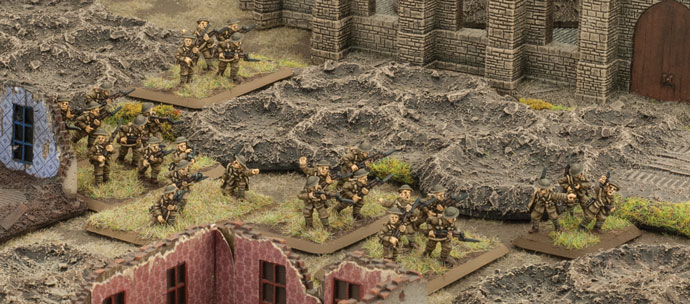
For those considered Elite Divisions or Assault Divisions there are two options, you can represent the best of the British divisions with the Elite Division Rifle Company, or the Dominion Divisions of Australia, Canada, and New Zealand with the ANZAC or Canadian Rifle Company.

All three Rifle Company are based around a core of 2 to 4 Rifle Platoons, with machine-guns and trench mortars for fire support. The Canadians, are a little different, and can take Armoured Autocar motorised machine-gun instead of standard Vickers HMGs if they choose.
The final formation is the Cavalry Squadron. The kept a number of cavalry divisions and brigade in reserve, ready for the exploitation phase of any offensive. During the Hundred Days campaigns at the end of the war they were finally able to show their advantages in mobile warfare.
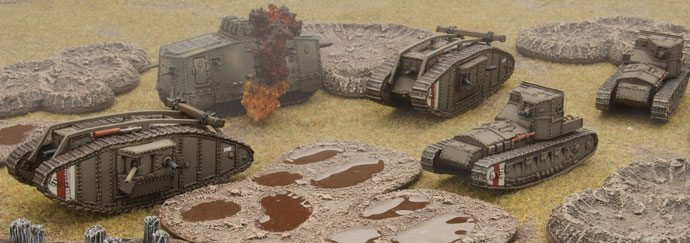
The British have wide selection of tanks. The Mark V and Mark V* tanks are a more reliable improvement on the Mark IV and was used in the later battles of 1918. The Mark V* introduced a new concept as a battle taxi. It was made longer to accommodate a section of infantry to be deployed from the tank once it had reached the enemy positions.
To fight alongside the cavalry in the exploitation the British also fielded Austin armoured cars. The Austin mounted a pair of machine-gun turret and was ideal for advancing along roads and the green fields of the rear areas.
The French
Any representation of the fighting on the Western Front is not complete without the French. Most of the fighting was on their soil and they held the majority of the front line. They were also tactical innovators, and just like the British and Germans, did much to devise ideas and methods for overcoming the tactical stalemate of the Western Front. They also had a wide variety of colonial troops fighting under their flag.
In Great War you can now field five French formations.
You can field four different infantry formations. The bulk of the French Army can be represented by the Metropolitan Compagnie de Fusiliers (Rifle Company) recruited from around France. France’s Colonial troops come from Frances colonies around the world and are found in the Compagnie de Tirailleurs (Light Infantry Company) and have a reputation for their aggressiveness as assault troops.
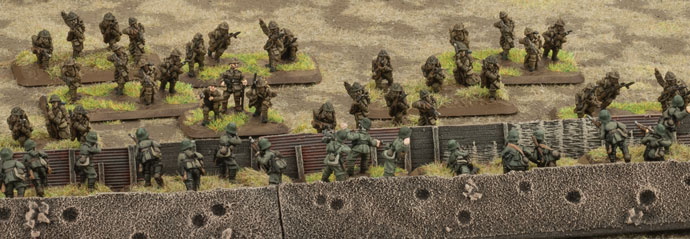
The other two formations are more unusual in that that are not French at all, just trained and equipped by the French and fighting under French command. These are the Compagnie de Fusiliers Russe (Russian Rifle Company) of the Russian Legion and the American Harlem Hellfighters Rifle Company. A Russian Expeditionary Force was originally sent to France by the Russian Tsar, and when the Revolution brought his reign to an end, some stayed on to fight for France as the Russian Legion. The Harlem Hellfighters were units of US 93rd Infantry Division made up entirely of African American soldiers. Due to American Army segregation it was decided to put them under French command, the French having no such problems with their race or fighting qualities. The French armed them, gave them combat training, and sent them into battle.
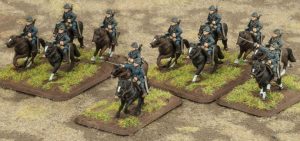 The final French formation is the Escadron de Cavalerie (Cavalry Squadron). Like the British the French saw Cavalry as something to be used for the final exploitation phase of an offensive. The French went on step further and actually integrated their White AM 1915/18 armoured cars into the squadrons.
The final French formation is the Escadron de Cavalerie (Cavalry Squadron). Like the British the French saw Cavalry as something to be used for the final exploitation phase of an offensive. The French went on step further and actually integrated their White AM 1915/18 armoured cars into the squadrons.
The French were quick to realise the advantages of the British tank and soon devised a number of their own design known as Char d’Assault (Assault Car). Two large vehicles were made and saw combat and shared many featured of the British and German tanks (Schneider CA.1 and Char Saint Chamond), but their most innovative design was the Renault FT-17. This light tank was small and relatively mobile with a fully rotating weapon turret. The rotating turret would heavily influence the design of tanks after the war.
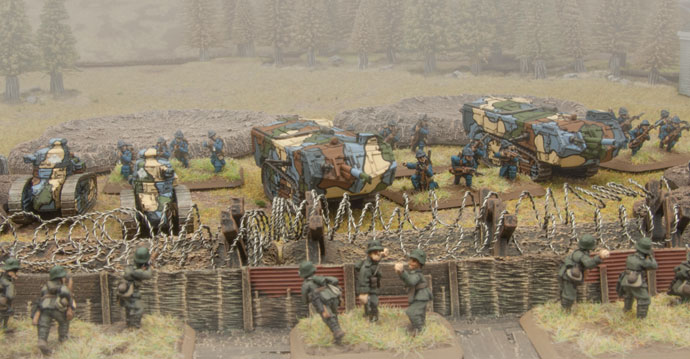
The Americans
The arrival of the American on the Western Front was celebrated by both the British and French. The French in particular as the Americans were deployed among the French Armies and trained in the latest French methods. The American commanders was fiercely independent and didn’t just want to make up the numbers. They were soon conducting operations of their own.
 In Great War you can field three different American Rifle Companies, 1st Infantry Division veterans, fresh 42nd Infantry Divisions and elite 4th Marine Brigade troops. The selection of the 1st and 42nd Infantry divisions does not limit your choice of them. Select your favourite divisions and use which ever one you think best suit them. American rifle companies are large with up to eight half platoons, with supporting firepower from machine-guns and mortars.
In Great War you can field three different American Rifle Companies, 1st Infantry Division veterans, fresh 42nd Infantry Divisions and elite 4th Marine Brigade troops. The selection of the 1st and 42nd Infantry divisions does not limit your choice of them. Select your favourite divisions and use which ever one you think best suit them. American rifle companies are large with up to eight half platoons, with supporting firepower from machine-guns and mortars.
Support can include British and French and they have their own tank support in the form of American crewed Renault FT-17 light tanks.
The Belgians
The Belgian Force contain one type of formation, the Compagnie d’Infanterie (Infantry Company). The Belgians held their particularly waterlogged sector of the line, hold on to the last remaining section of their homeland not occupied by the Germans. This they held with great tenacity.
Missions
Great War comes with four specialist Great War missions and nine general missions suitable for the open warfare of the Hundred Days campaign.
With this new book, Great War is expanded out to cover most of the battles of the Western Front in 1918 (and quite a few in 1916 and 1917). It’s time to break through the enemy’s lines and advance into the green fields beyond!
~Wayne
Manufacturing update

Manufacturing update – 30th July 2021
Malaysia remains in a strict nationwide lockdown in response to the COVID19 surge they’re experiencing. This includes the Battlefront factory where we make all our 15mm ranges, which has now been closed for over two months, and will remain so, until it is deemed safe to re-open by the government. We have always had a long lead time for production so our stocks on hand have been able to cope but with the length of this closure we have already started seeing the impact hitting the range on the delivery of new items and the restocks of the current range.
When we re-open, we’re going to have to prioritise the flow of product as we simply cannot make it all in one go so we will concentrate on getting our upcoming new releases finished, packed and on their way to the warehouses, stores and yourselves as the top priority. As well as the new products we will work on the core lines as our goal is to see that the entire Late-War and WWIII ranges fully stocked.
To enable us to do this, and catch back up, we’re going to TEMPORARILY suspend orders for some of our ranges so that the factory can focus their efforts as with over three thousand codes the exercise of making replacement stock for them all will take the plant some time to catch up. NAM, Great War, Arab Israeli, Early War and Mid War will be suspended in their entirety. All special / direct order codes, as these are made to order, and some of the BIAB terrain range will also be suspended.
We understand this is sad news and might disrupt some of your collecting and building plans, and we heartily apologise. Please be reassured this is temporary, and we will get those ranges back into production, as soon as we have caught up with the amended release schedule.
Great War FAQ – Notes From The Recent Fighting
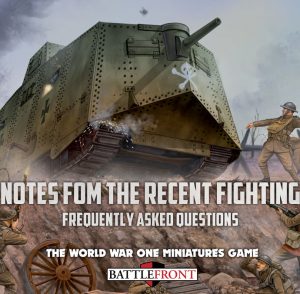
A new rules set always results in questions about how the finer points of the game should work so Notes From The Recent Fighting is the place to go to find answers to some of the harder questions.
Notes From The Recent Fighting (PDF download)…
Notes From The Recent Fighting – Printer Friendly (PDF download)…
Great War Quick Reference Sheet Download
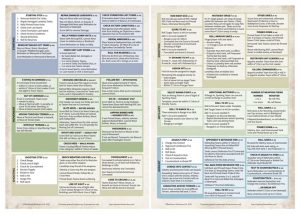 Numerous people asked for a handy printable version of the quick reference sheet so we have made a PDF version for you to download and print out, and perhaps have it laminated.
Numerous people asked for a handy printable version of the quick reference sheet so we have made a PDF version for you to download and print out, and perhaps have it laminated.
Click here to download the Great War Quick Reference Sheet (PDF) (Right-click, Save As)…
The Great War: The Battle of Saint Quentin
Our group – the Flames Of War Regina Rifles, FRR, has events almost every month and sometimes more than
once a month. And, every second month we have a large team game. Next month in March there will be a
large Great War Battle.
The Great War: Battle of Saint Quentin
with Lance Matthews
Our group – the Flames Of War Regina Rifles, FRR, has events almost every month and sometimes more than
once a month. And, every second month we have a large team game. Next month in March there will be a
large Great War Battle.
I have owned Great War Germans for years. And while I have slowly worked on them they still need quite a bit
of work. However, my son was on the fence about what he wanted and last year he decided that French
Cavalry was the choice. Well, it took a while and ‘tanks’ to the sale on Great War items we finally bought the
last FT-17. Unfortunately, that is where we are now – we own all the models and blisters! Cringe – but they are
still mostly in the packages. Now, until the 21 st of March we will be assembling and painting like fiends in an
effort to make the French battle ready!
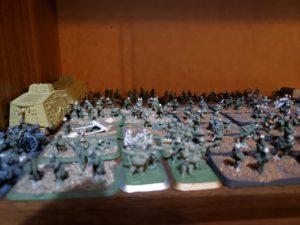 Great War Germans:
Great War Germans:
Infanteriekompanie HQ – 2 points
– 2 Mauser pistol teams
Infanteriekompanie Platoon – 18 points
– 6x G98 rife teams
– 2x MG 08/15 teams
– 1x Flamethrower team
– 1x 1.3cm anti-tank rifle
– 1x M1917 rifle grenade team
Infanteriekompanie Platoon – 14 points
– 6x G98 rife teams
– 2x MG 08/15 teams
– 1x Flamethrower team
– 1x M1917 rifle grenade team
Machine Gun Platoon – 14 points
– 3x Maxim MG 08 HMG teams
Werfer Section
– 2x Granatenwerfer mortars – 6 points
3.7cm Anti-tank Gun – 8 points
A7V Panzer – 19 points
A7V Panzer – 19 points
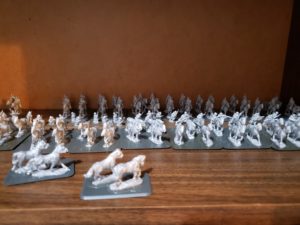
Great War French Cavalry:
Escadron De Cavalerie HQ– 2 points
– 2x Lebel pistol teams
Cavalerie Platoon – 14 points
– 6x Berthier rifle teams
– 2x VB Rifle grenade teams
– 1x Chauchat MG team
Cavalerie Platoon – 14 points
– 6x Berthier rifle teams
– 2x VB Rifle grenade teams
– 1x Chauchat MG team
Cavalerie Machine-Gun Platoon – 9 points
– 2x Hotchkiss HMG Team
Renault FT-17 Char D’Assaut Platoon – 36 points
– 2x Renault FT-17 (MG)
– 3x Renault FT-17 (37mm)
Char Saint Chamond Tank – 21 points
Sniper – 4 points
Looking closely, in the above photo, you will notice some of the bases are upside down. This is by intent, as one cavalry
platoon will be right side up and the other will be as mentioned upside down. When dismounted one “infantry” platoon
will be right side up and the other, you got it, upside down to match. Also, if you look closely at the right front large base
one of the horses appears shorter than the others – that is because it is a mule that is stuck carrying the ammo for the
Chauchat MG team.
And that is all we have managed to assemble so far, the rest being similar to the below photo:
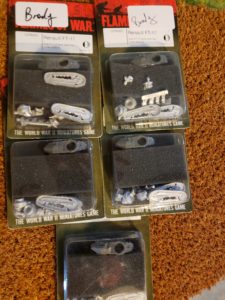 Well, wish us luck on our assembly and massive painting project!
Well, wish us luck on our assembly and massive painting project!
Meanwhile, our opponents/team mates are also working hard at assembling their troops for the epic battle!
Jace P – French
Kyle S – British
Matt V – Canadians
Conner J – Germans
Jeff S – Germans
Ryan J – Germans
And, those are just the players that we have that are raring to go!
As my son and I scramble our fighters so do the rest of our group of allies and enemies work hard to assemble
and make ready their own forces for the ‘Great’ game. Matt has been itching to play as he has recently
purchased a Canuck Force. Canucks – I shake my head. Not to be out done Kyle who has owned his army
since the original release, and much like me, is also now working feverishly to finally finish painting his
collection.
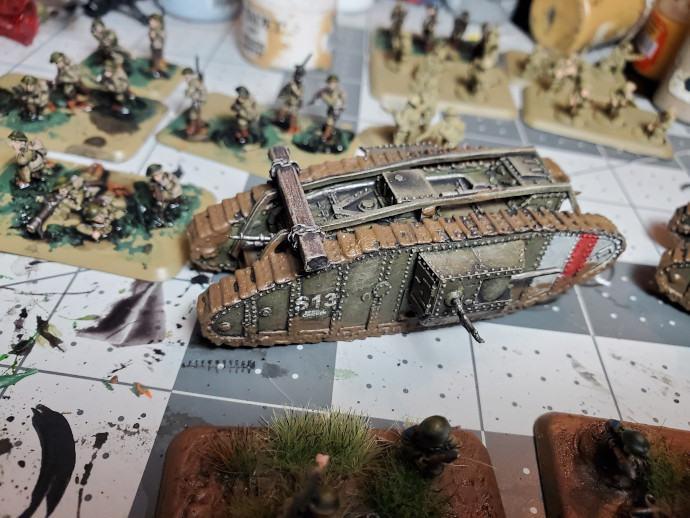
Matt’s list of Great War Canadians:
Canadian Rifle Company HQ – 2 points
– 2 Webley pistol teams
Rifle Platoon – 15 points
– 5x SMLE Rifle Teams
– 2x Hales Rifle Grenade teams
– 2x Lewis MG teams
Rifle Platoon – 15 points
– 5x SMLE Rifle Teams
– 2x Hales Rifle Grenade teams
– 2x Lewis MG teams
Armoured Autocar – 20 points
– 2x Armoured Autocars
Sniper – 4 points
– 1x sniper (1 man, 1 rifle, 1 shot)
Field Battery, Royal Canadian Artillery – 25 points
– 3x OQF 18 pound gun (Green)
Mark IV Male Tank – 17 points
– 1x Mark IV Male Tank (Green)
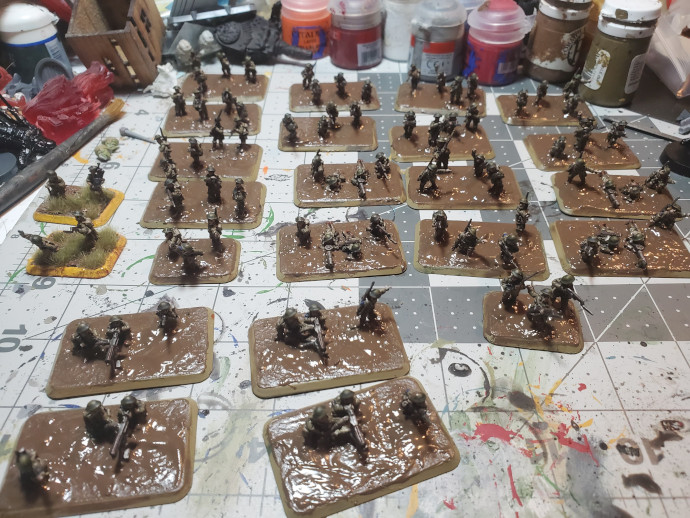
But, we have a problem.
Kyle has decided to switch from British to Canadians. I tried to explain to him that Canada is a back water
nation; they probably sent their soldiers to the Great War with hunting rifles instead of army issue weapons. I
even further pestered him suggesting that their soldiers probably had shovels with holes in them. Undeterred
he stood his ground wanting to play them. I went as far as to suggest that the Canadians probably did not even
receive gas masks but were instead forced to use urine soaked rags to stave off the deadly effects of mustard
gas. Kyle countered that the Canadians were elite troops. Elite troops – they probably spent most of the war
hopping trains to get from place to place instead of fighting.
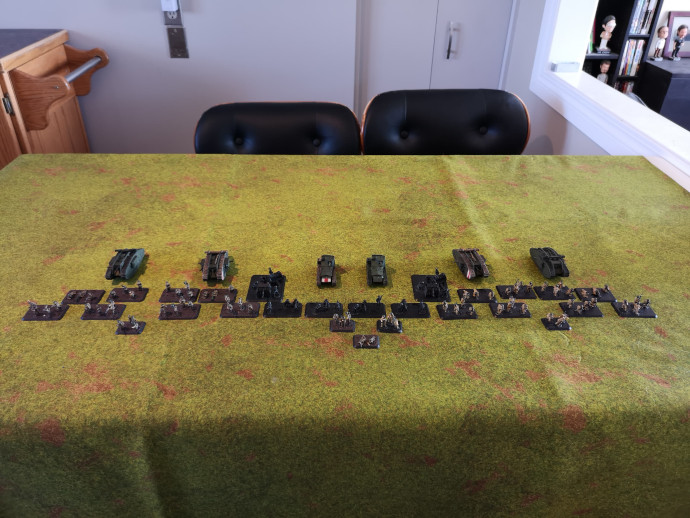
He seems pretty stubborn about it so I guess we have another Canadian army on the field instead of proper
British troops.
Kyle’s list of Great War Canadians:
Canadian Rifle Company HQ – 2 points
– 2 Webley pistol teams
Rifle Platoon – 15 points
– 5x SMLE Rifle Teams
– 2x Hales Rifle Grenade teams
– 2x Lewis MG teams
Rifle Platoon – 15 points
– 5x SMLE Rifle Teams
– 2x Hales Rifle Grenade teams
– 2x Lewis MG teams
Veteran Field Gun – 11 points
– 1x OQF 18 pound gun
Mark IV Male Tank – 23 points
– 1x Mark IV Male Tank (Veteran)
Mark IV Male Tank – 23 points
– 1x Mark IV Male Tank (Veteran)
Mark A Whippet Tank – 11 points
– 1x Mark IV Male Tank (Veteran)
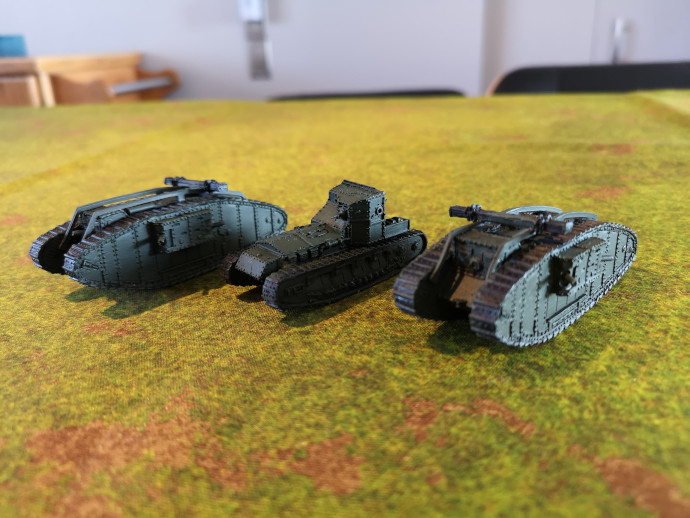
Stay tuned for the After Action Report, AAR, next month. Which will, of course, include a lot more painted miniatures!
Or, hopefully a part three which will show our progress as well as some of our opponents/team mates lists!
Great War Sale Ending Soon
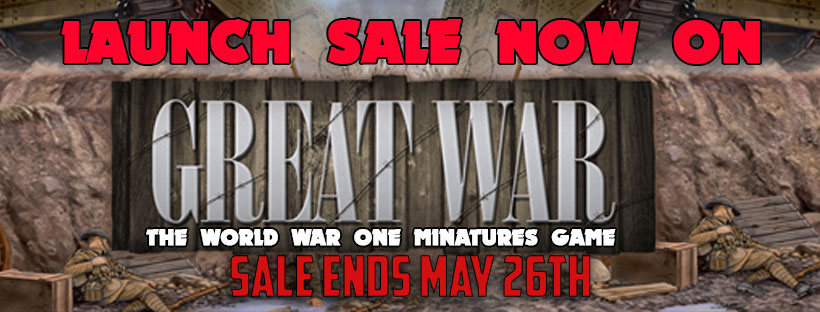
The Great War Launch Sale is ending on May 26th. Whether you are looking to add some new units to your existing armies, or start a completely new one now is a great time to take advantage of the 25% Discount Launch Sale.
Canadians in the Hundred Days
 It’s the summer of 1918, after a massive effort the Western Front has stabilized after the surprisingly aggressive German spring offensive. Though most of the General Currie’s Canadian Corps held the line around Vimy Ridge during this period, one of his most valuable units, under Major Raymond Brutinel’s, the Motor Machine Gun Corps provided much needed mobile firepower at critical moments. In June of 1918, he gives a speech at a supper club in London extolling the achievements of the allied forces but cautioning his audience that Germany is far from beaten, hard work and loss of life are necessary to bring the war to an end, an end which he believes will be in 1919. How did he get to this point in history
It’s the summer of 1918, after a massive effort the Western Front has stabilized after the surprisingly aggressive German spring offensive. Though most of the General Currie’s Canadian Corps held the line around Vimy Ridge during this period, one of his most valuable units, under Major Raymond Brutinel’s, the Motor Machine Gun Corps provided much needed mobile firepower at critical moments. In June of 1918, he gives a speech at a supper club in London extolling the achievements of the allied forces but cautioning his audience that Germany is far from beaten, hard work and loss of life are necessary to bring the war to an end, an end which he believes will be in 1919. How did he get to this point in history
Canadians in the Hundred Days…
Canadians in the Hundred Days
with Bill Balding

It’s the summer of 1918, after a massive effort the Western Front has stabilized after the surprisingly aggressive German spring offensive. Though most of the General Currie’s Canadian Corps held the line around Vimy Ridge during this period, one of his most valuable units, under Major Raymond Brutinel’s, the Motor Machine Gun Corps provided much needed mobile firepower at critical moments. In June of 1918, he gives a speech at a supper club in London extolling the achievements of the allied forces but cautioning his audience that Germany is far from beaten, hard work and loss of life are necessary to bring the war to an end, an end which he believes will be in 1919. How did he get to this point in history?
At the beginning of the war, Britain asked for and received a commitment for troops from their Dominions. In the case of Canada, the firebrand Minister of Militia Sir Sam Hughes scraps the existing mobilization plans and calls for volunteers. Though there was a small corps of Permanent Force officers and enlisted troops, Hughes decides to officer the Canadian contingent with militia officers and picks men he knows. Sir Richard Turner, Arthur Currie, and Malcolm Mercer, all militia veterans, were chosen to lead the three brigades of the Canadian Expeditionary Force with many of the staff positions filled by British officers who had experience in respective areas. British General Sir Richard Alderson is appointed the commander of the Canadian Division.
The Canadians gain their first combat experience at the Second Battle of Ypres experiencing the pain and horror of gas warfare. Over the next year due to battlefield mistakes, poor intelligence, coordination, and personality conflict General Alderson would be replaced by another British General, Sir Julian Byng recently returned from the evacuation of Gallipoli. The three original brigades are expanded into Divisions creating the Canadian Corps. All three Colonels become Brigadiers however in the summer of 1916, Malcolm Mercer accompanied by his aide and escorting troops come under fire from the German lines during reconnaissance near Mt. Sorrel. During counterbattery fire British shell fragments kill Mercer, the surviving personnel becomes prisoners for the rest of the war. Louis Lipsett replaces him, a British officer who served and instructed in Canada before the war. With the loss of territory in their sector, Currie approaches Byng with a plan using set piece objective tactics for regaining lost ground and is successful; however, this followed by months of the back and forth fighting at the Somme, which sees few tactical gains. One of the few benefits won by a primarily Francophone unit; the 22nd Battalion succeeds in taking the town of Courcelette. During the summer/fall of 1916 the 4th Division takes their place within the Corps under General David Watson, another pre-war militia officer, who like the first three, owed his initial placement to Minister Sam Hughes. As the 4th is “new” to the front, they remain at the Somme when the other three Divisions rotate out of the line.
Over the next months, senior personnel changes occur which affect the Corps. Sir Richard Turner, is rotated to England taking command of the Canadian Forces in England responsible for the training and assignment of replacements troops. 2nd Division command assumed by Henry Burstall, a long-serving Artillery officer from the Permanent Force. In early January 1917, Currie is detailed to an allied officer conference studying the lessons from the French defense of Verdun and the Somme. He returns with a report whose experiences are the framework for Vimy Ridge, Hill 70, Avion, and Passchendaele. The Canadians reputation gains them respect on both sides of the lines, and in 1918, Currie’s peer General Monash of Australia requests their assignment on his flank in the upcoming late summer offensive. The attack is scheduled to kick off at Amiens and launch what is known today as the “One Hundred Days” campaign. With the breaking of the Queant-Droucourt line in early September, open warfare returned to the Western Front. Depending on the objective Currie and his Generals adopted their tactics utilizing set piece tactics and mobile units as necessary. In the first week of November 1918 Canadians were moving into Mons, Belgium occupying favorable positions just before the armistice on November 11th. Though Currie and troops would spend more time in Europe as part of the occupation force, in only four years, the Canadian Forces had evolved from a mainly part-time militia to a highly effective, respected, feared fighting force.
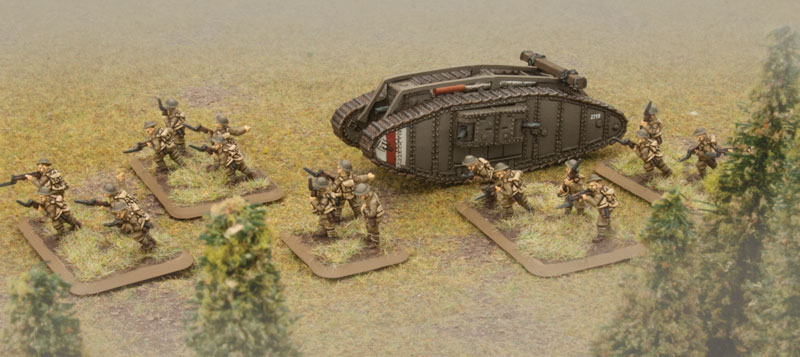
Historical Missions:
Battle / Date/ Mission Special Rules/ Recommended Mission
Amien, August 8, – Preliminary Bombardment (Creeping barrage, German rolls for affected Infantry/gun saves), Dawn, The Big Push
Though the Canadians had spent much of the spring and summer in the vicinity of Vimy Ridge they were requested by the Australian commander Sir John Monash to be his right flank at Amiens beginning the summer/fall offensive known as The Hundred Days. Their objective was Hill 102, just South West of the Beau Count rail line. British 3rd Corps on the left flank, Australian Corps in the center with the Canadian Corps (2nd, 1st, and 3rd Divisions) on the right flank, with the 4th Division in reserve. There would be no preparatory bombardment masking the assaults launch; this would become characteristic of the Canadians planning to the end of the war. The Corps preferred to keep the enemy off balance with the Counter-battery fire and the combined creeping barrage of Field Artillery and Machine guns.
One of the most significant changes was that the Creeping Barrage would lift every two minutes and move forward 100 yards, one year prior at Passchendaele the CB lifted every eight minutes. This faster pace supported a more aggressive assault on the enemy positions. Due to surprise and the CB, the German defenses do not withstand the initial onslaught. However, with the fog burning off the German Anti-tank guns and artillery fire on the tanks. Over the next three days due to stiffening resistance and gun discipline the 342 tanks which began the battle on August 8th reduces to 38 by the 11th. Also, the lack of training between the infantry and tank crews results in infantry halting upon encountering a machine gun nest or pillbox, and once tanks had broken down the infantry would cease their forward movement until operational armor arrived. Cavalry was present but lacked coordination with Infantry and Armor to create a pursuit upon breaking through the lines. Despite these shortfalls, they inflict 000’s of casualties upon the Germans, gaining more territory than ever during the war.
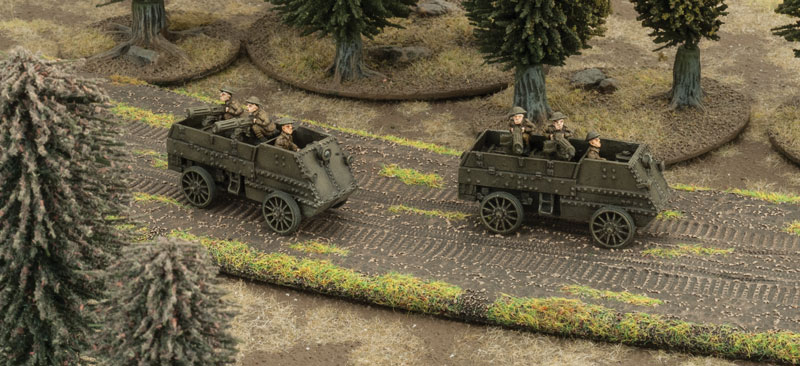
The German leadership referred to August 8th as “The Black Day of the German Army.” The first day saw the “Whippet Rampage,” after losing tanks in his platoon one tank commander continues seeking out targets only stopping after his tank catches fire from leaking gas cans shot up during the fighting. The Mark V and Tadpole tanks were used supporting the infantry with the Tadpoles carrying MG crews forward to provide additional counter attack protection for the infantry. Additionally, RAF and French aircraft aided the ground assault, Currie as other Allied commanders were learning the value of integrating air into their battle planning.
Upon reaching the old Somme battlefield, the British leadership suspended the attack with input from the Canadians determined continuing the assault across such defenses would yield little strategic advantage, returning to set piece Trench Warfare, and shift their attention to German-held areas of Arras, shielding Cambrai the logistical heart of the Kaiser’s armies.
Arras, August 26-28, Preliminary Bombardment (Creeping barrage, German rolls for affected Infantry/gun saves}), Nighttime, Through the Mud and Blood
Just beyond Arras was the Quent- Drocourt line* “hinge of the Hindenburg line,” breaching this obstacle enables the Allies the ability to roll up on the German flanks both north and south. To get there, they would have to break through the fortifications in front of Arras. Until reaching Mons, this would be the Canadians area of operations.
A nighttime attack was planned, as primarily Infantry / Artillery assault. The objective was the Arras – Cambrai road for further movement on the Q-D line itself. Only eighteen tanks were assigned to the assaulting divisions, this due to prior combat losses and mechanical failure, evidence of the limitations of new technology. Conversely, a lot of airpower took part in both close air support and aerial bombardment both day and night. As with earlier plans, there was no preparatory bombardment, the creeping barrage by Field artillery, counter-battery by Heavy guns (mostly British units) and machine gun bombardment began at 3 a.m. catching the Germans off guard. The assaulting divisions were the 2nd, 3rd and Scotland’s 51st Highland Division. After several days of hard fighting, due to heavy casualties and poor weather grounding all planes, negating the allies advantage of air cover resulted in a suspension of the assault. The Germans pulled back to the Q-D line protecting the approach to Cambrai. General Currie referred to this as “The hardest battle in its history.” Relieving their surviving comrades, the 1st, 4th, and British 4th Divisions assumed front line positions.
Quent – Drocourt Line, September 2, (Creeping barrage, German rolls for affected Infantry/gun saves}) Dawn, Through the Mud and Blood
Breaking through the Q-D Line provided an opportunity for flanking attacks both north and south. The objective was the Arras-Manquin road just beyond the fortifications. The positioned Divisions had the support of 20 Field and 11 Heavy Artillery batteries. Heavy guns both isolated the battlefield from a counter attack and using counter battery fire eliminating the German guns. This time the Canadians moved the Field guns forward every three minutes keeping pace with advancing Infantry and tanks. Once the weapons reached the Q-D Line, they would halt continuing for thirty minutes to disrupt local counterattacks. For this effort, the assignment of two Mark V companies along with strong air support provide mobile fire support.
The whistles blew at 5 a.m. with the barrage just ahead of the Infantry and Tanks along a 7,000-yard front. Despite gains made the Germans held up the 4th at Mount Dury, eventually driven off though, with heavy casualties, the 1st went after the Buissy Rail switch. Rather than fight with their backs to water the Germans retreating beyond the Sensee River and Canal du Nord. This withdrawal cost them the gains made during the previous spring’s Blucher Offensive and caused them to initiate requests for armistice terms. The Canadians realized that the days of trench warfare were truly over. Now the unique obstacle of Canal du Nord lay in their way.
Canal du Nord, September 27, Preliminary Bombardment (Creeping barrage, German rolls for affected Infantry/gun saves}), Dawn, Delayed Reserves for Canadian tanks and MMG units, Bridgehead
The immediate objective was to get the 1st and 4th Divisions across the dry canal bed and into the town of Bourlon and Bourlon Wood. The dry bed constrained the assaults front to two thousand yards. If the Germans guessed correctly, they had the Canadian troops pinned into a tight killing zone. Though Currie was cautioned against this plan by several senior officers, he insisted the Corps could pull it off. After the initial success of the lead troops, the 3rd and British 11th Divisions continue exploiting, expanding the attack towards Cambrai if possible. This time the 2nd Division took the position as the reserve force.
No preparatory bombardment was used misleading the Germans to point and time of the attack. Counter Battery Staff Office used Sound ranging, Triangulation and aerial reconnaissance determining the location of opposing batteries which they hit with gas and High Explosive rounds silencing the preponderance of Hun guns. 18 Pounders for Creeping Barrage were planned to be moved forward in relays taking advantage of their lethal range along with the MG barrage. The canal crossing was successful and demonstrated an ability to coordinate the various combat and Support branches in executing the assault, pushing well past the canal while defending from counter attacks is a tribute to leadership’s planning and the implementation by the coordinating units. The next step was taking Cambrai, strangling the Germans supply lines.
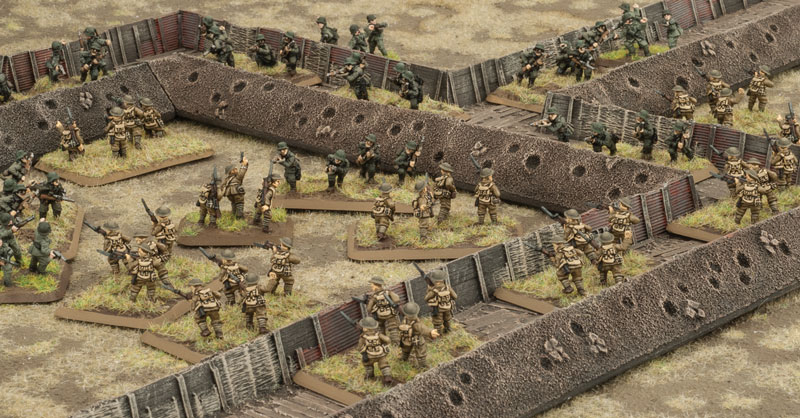
Cambrai, October 9, Preliminary Bombardment (Creeping barrage German rolls for affected Infantry/gun saves}), Dawn, Strategic Withdrawal, Rearguard
Germans retreated out of Cambrai without making a coordinated effort contesting it, what they did not take with them was set on fire. Canadian Engineers moved quickly dousing as many flames as possible. Localized counter attacks by Germans including captured Mk V’s (Beute Panzers) supported by infantry took on Currie’s Field Artillery. The gunners engaged the tanks over open sights destroying or driving them off while Raymond Brutinel’s Motor Machine Gun Brigade eliminated the infantry assault.
Valenciennes, October 31- November 2, Preliminary Bombardment (Creeping barrage, German rolls for affected Infantry/gun saves}), Dawn, The Green Fields Beyond
Counter-Battery fire, point blank Field Artillery used for creeping barrage, Motor Machine Gun barrage
The battle for Valenciennes depended upon control of Mount Houy with its commanding view of the city and surrounding terrain. Between October 24th to 28th, the British XXII Corps temporarily attained the summit and subsequentially been driven off by German counterattacks. Upon receiving his orders, General Currie turned to his Heavy Artillery officer Andrew McNaughton and Counter-Battery Staff Officer Henry Crerar. They developed a plan to barrage enemy positions and possible assembly areas eliminating a substantial amount of the threat destroying 110 enemy guns. Along with MG barrages, the infantry assault swept the Germans from Mount Houy and into the city. Anticipating the German practice of immediate counter-attacks the Canadians moved Heavy Artillery forward shelling the expected assembly areas.
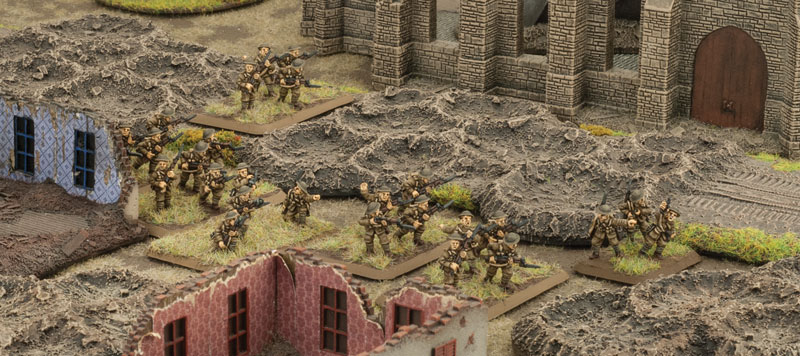
Mons,
Late on the night of November 10th, Canadian troops entered the city of Mons almost four years since the British had retreated from it. Though expected, armistice confirmation did not reach General Currie until six a.m. on the 11th. An armistice is not a peace treaty. Knowing that, each commander sought the best tactical position their troops could occupy.
The Great War Channel – The Russian Civil War in Early 1919
We sponsored an episode of the always excellent The Great War – The Online Video Series! Check it out and you might just find a special offer for The Great War viewers.
Great War Launch
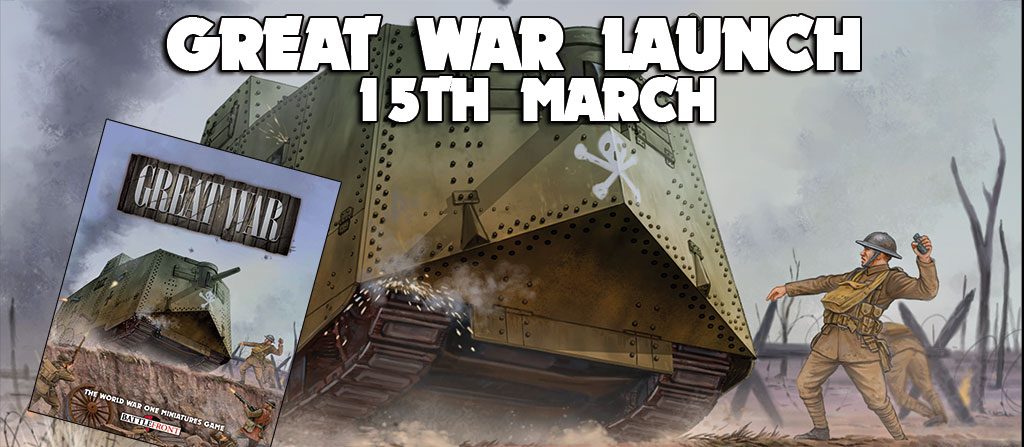
On the 15th of March we had the Great War Launch. During this time we updated the website with plenty of information, lists and pictures and a fun day was had by everyone here.
Check out all the content we posted in the links below.
Great War Q&A…
Know Your Germans- Great War…
Know Your British – Great War…
Know your French – Great War…
Know your Americans – Great War…
Planning a Great War Army (Belgium) Part 1…
Planning a Great War Army (Belgium) Part 2…
Weathering Great War Tanks…
German Infantry Painting Guide…
Aaron’s Great War…
